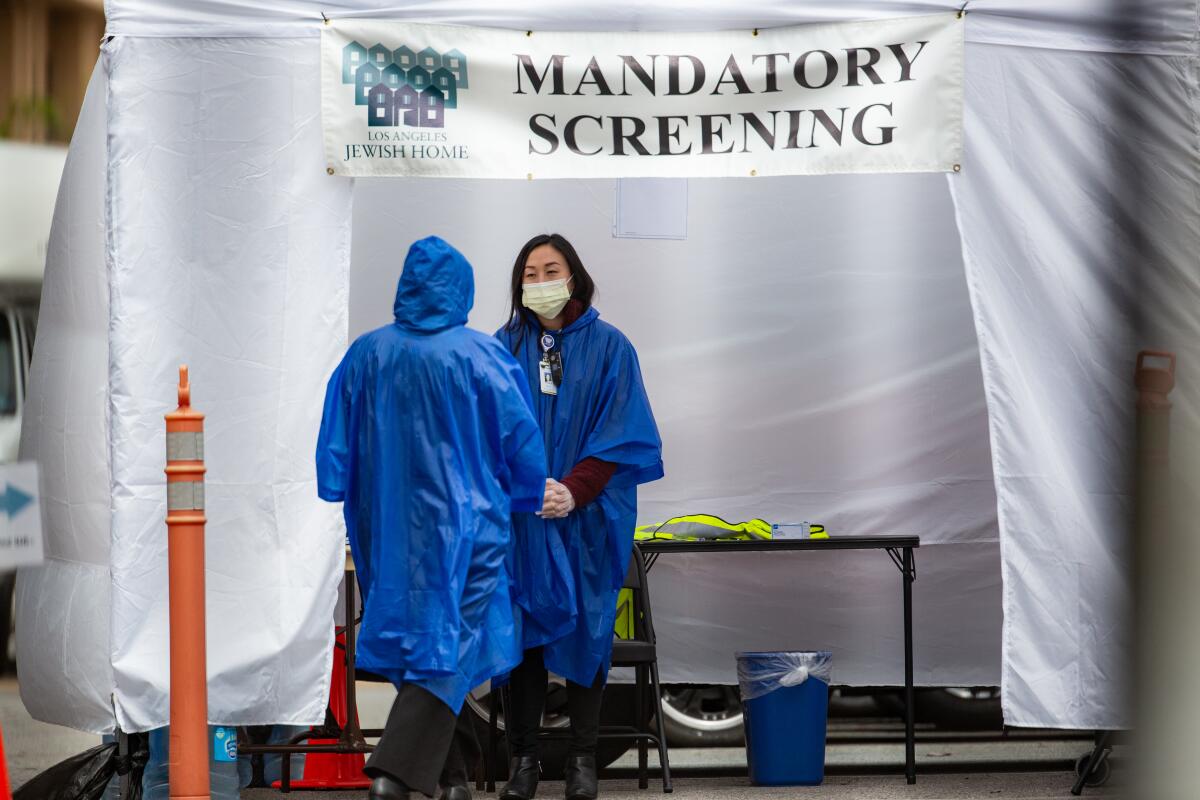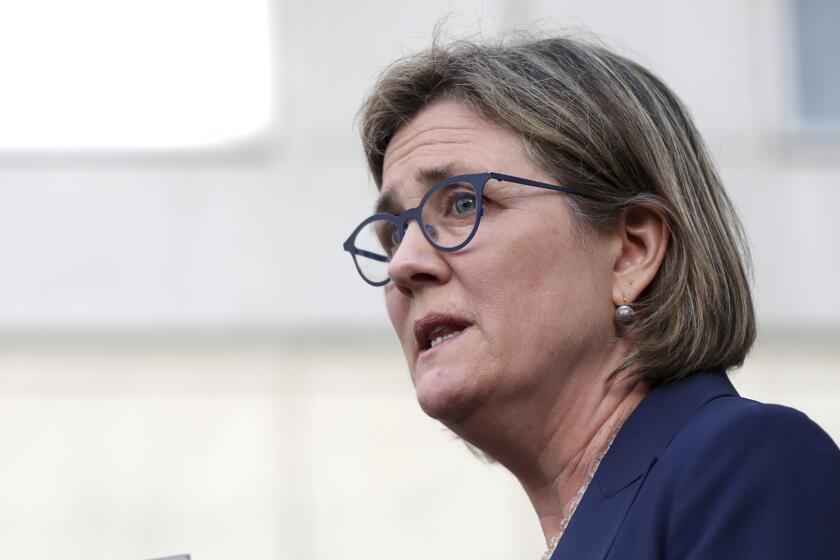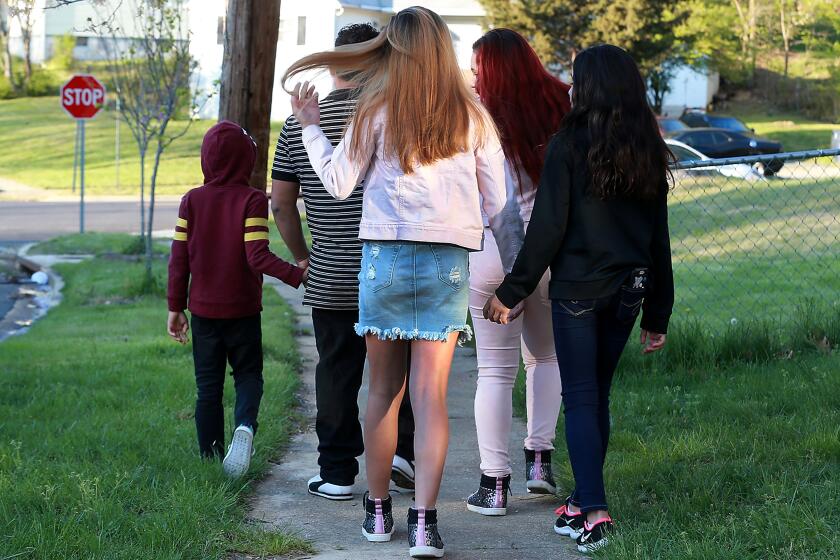California requires universal testing at nursing homes, overruling L.A. County

- Share via
California’s health department has issued new instructions to all skilled nursing facilities to test everybody in their facilities in hopes of slowing the spread of the coronavirus, a move that overrules a more lax testing policy allowed by Los Angeles County.
Nursing homes have become ground zero for the COVID-19 pandemic because elderly people with underlying health conditions living in close quarters provide an almost perfect breeding ground for the lethal new virus. A Times data analysis earlier this month found that about half of all coronavirus deaths in California occurred in skilled nursing or assisted living facilities.
California’s new testing guidelines for skilled nursing facilities come as health officials in states across the country, including New York, New Jersey, Florida and Texas, have concluded that the best way to get a handle on the unfolding tragedy is to test both residents and staff in nursing homes and isolate anyone who is positive, especially asymptomatic employees who sometimes work at multiple homes and can easily spread the virus from facility to facility.
But the devil has been in the details: finding enough test kits, determining how frequently to test and deciding who will pay for it all.
State health officials sent a letter to all skilled nursing facilities in California instructing them to test all residents and staff at least once. If a home shows no cases, it must continue to test 25% of residents and healthcare workers on a weekly basis and ensure that all staff members are tested once per month.
That goes much further than guidance from L.A. County, which, as the Times reported last week, had instructed homes with no cases that they could skip testing staff and test only 10% of residents weekly.
“Nursing home residents, and the healthcare personnel who care for them, are among our most vulnerable for COVID-19 infections,” said California’s health and human services secretary, Dr. Mark Ghaly, after the state issued the new instructions. “Mandatory testing will provide the knowledge we all need to make informed care decisions.”
A key architect of the nation’s first coronavirus stay-at-home order says California’s fast pace of lifting restrictions “poses a very serious risk.”
The testing directive comes as officials are demanding health agencies do more to reduce the crisis in nursing homes.
On Tuesday, the Los Angeles County Board of Supervisors voted unanimously to appoint an independent inspector general to look into the county’s oversight of nursing homes, including the county health department’s slow testing.
“What’s been most frustrating for me is that time and time again, when we listen to the death count that this horrible virus has caused, all roads lead back to our skilled nursing facilities,” said Supervisor Kathryn Barger before the vote.
Tens of thousands of residents in elder care homes have died of the disease in the United States. Nearly a thousand have died in LA County alone, accounting for about half of the COVID-19 deaths in the county.
As nursing homes in the United States first began to grapple with the coronavirus in early February, most were testing only residents who showed symptoms. If they found someone was positive, the homes quarantined them from other residents and also banned visits from friends and family.
As outbreaks multiplied, it became clear that at least some were being sparked by staff — who could pick up the virus at home, on the bus, or at one of the other nursing homes where they worked. So facilities started testing symptomatic employees as well.
Then, in late April, as the COVID-19 death toll approached 300 in L.A. County nursing homes — a relatively modest toll compared to where it stands now — Los Angeles County health director Barbara Ferrer announced an aggressive new plan to test everyone inside nursing homes in an effort to turn the grim tide.
The move was necessary because it had become clear the virus was spread by people who had no symptoms, Ferrer said.
So last week, advocates for the elderly were shocked when The Times reported that L.A. County health officials were still far behind in their pledge to test everyone in nursing homes, having completed the process in only about a third of the facilities in the county.
They were also surprised to learn county officials had sent a letter advising homes with no confirmed cases to test only a small sample of residents — not staff — on a weekly basis.
Ferrer defended the policy change as a “wise move” that allowed the county to focus efforts on facilities with the worst outbreaks, but many critics were unimpressed.
Three children are fighting government efforts to take them from their father and deport them to El Salvador to no one. They’re far from alone.
“There are undoubtedly more people who have died because of that inaction,” said Dr. Michael Wasserman, president of the California Assn. of Long Term Care Medicine, which represents doctors, nurses and others working in long-term care facilities.
“It’s disgraceful that the county would take a step backward on testing at a time when dozens of nursing home residents are dying from the coronavirus almost every day,” said Michael Connors, a spokesman for California Advocates for Nursing Home Reform.
At her daily briefing on Wednesday, Ferrer said the county would comply with the new guidance from the state.
She also noted that of the 30 healthcare workers who have died of COVID-19 in L.A. County, 22 were employees at skilled nursing facilities — by far the highest toll among healthcare professionals.
Ferrer came under fire this week from local political leaders for her department’s handling of the coronavirus outbreak.
Supervisor Mark Ridley-Thomas said the high death rate in nursing homes is “directly a result” of inattention and a lack of appropriate oversight of nursing homes that predates the pandemic.
“The suffering, the misery, the low quality of care” in nursing homes all should have been addressed before the crisis began, he said.
More to Read
Sign up for Essential California
The most important California stories and recommendations in your inbox every morning.
You may occasionally receive promotional content from the Los Angeles Times.













